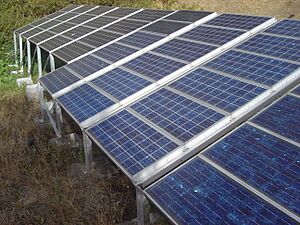Photovoltaic effect facts for kids
The photovoltaic effect is how some materials can create voltage and electric current when light shines on them. It's a natural process that turns light energy directly into electrical energy.
This effect is very similar to the photoelectric effect. In both cases, light hits a material, and its energy makes tiny particles called electrons move to a higher energy level. The main difference is where these electrons go. In the photoelectric effect, electrons are usually kicked out of the material. But in the photovoltaic effect, the excited electrons stay inside the material. This movement of electrons creates an electric potential, which is like a push that makes electricity flow.
Contents
History of the Photovoltaic Effect
The photovoltaic effect was first shown in 1839 by a French scientist named Edmond Becquerel. He used a special setup with two metal plates (platinum or gold) in a liquid. When one plate was exposed to sunlight more than the other, it created an electric current. This was the first time someone showed that light could directly make electricity in this way.
Later, in 1884, an American inventor named Charles Fritts made the very first solar cell. It was made of a layer of selenium covered with a thin film of gold. However, this early solar cell was not very good at turning light into electricity. It was a big step, though, showing that solid materials could also create electricity from light.
Today, most devices that use the photovoltaic effect are called photodiodes or solar cells. They are made from special materials called semiconductors.
How the Photovoltaic Effect Works
When light hits a material that can create the photovoltaic effect, it gives energy to the electrons inside. These electrons get excited and start to move freely.
In solar cells, these excited electrons move towards a special area called a "junction." This junction acts like a one-way street, pushing the electrons in one direction. This movement of electrons creates an electromotive force (a kind of electrical pressure) and an electric current. This is how light energy is changed into electrical energy.
Light and Electron Movement
Imagine the material has different energy levels for electrons, like steps on a ladder. When light (made of tiny energy packets called photons) hits the material, it gives energy to electrons on a lower step. If the light has enough energy, it can push these electrons to a higher step, making them free to move.
These free electrons then move through the material. In a solar cell, the way the material is built helps to separate these moving electrons from their "holes" (the empty spots they left behind). This separation creates an electrical imbalance, which is what causes voltage and current.
Temperature's Role
The temperature of a solar cell can affect how well it works. When a solar cell gets hotter, its ability to produce power usually goes down. This is because high temperatures can change how easily electrons and "holes" move around inside the cell.
Scientists use special numbers called "temperature coefficients" to describe how much a solar cell's performance changes with temperature. For example, the voltage it produces tends to decrease as the temperature rises.
Solar Cells: Using the Effect
The most common use of the photovoltaic effect is in solar cells. These devices are designed to capture sunlight and turn it into usable electricity.
In a typical solar cell, there's a special boundary inside called a "p–n junction." When sunlight hits this junction, it creates free electrons and "holes." The built-in electric field at this junction then sweeps these electrons and holes in different directions. This organized movement is what generates the electric current we use.
Some newer research is even exploring how to create alternating current (AC) directly from the photovoltaic effect, instead of just direct current (DC). This is still being developed, but it could make solar power even more versatile in the future.
See also
- Theory of solar cells
- Electromotive force in solar cells
- Photoelectric effect


